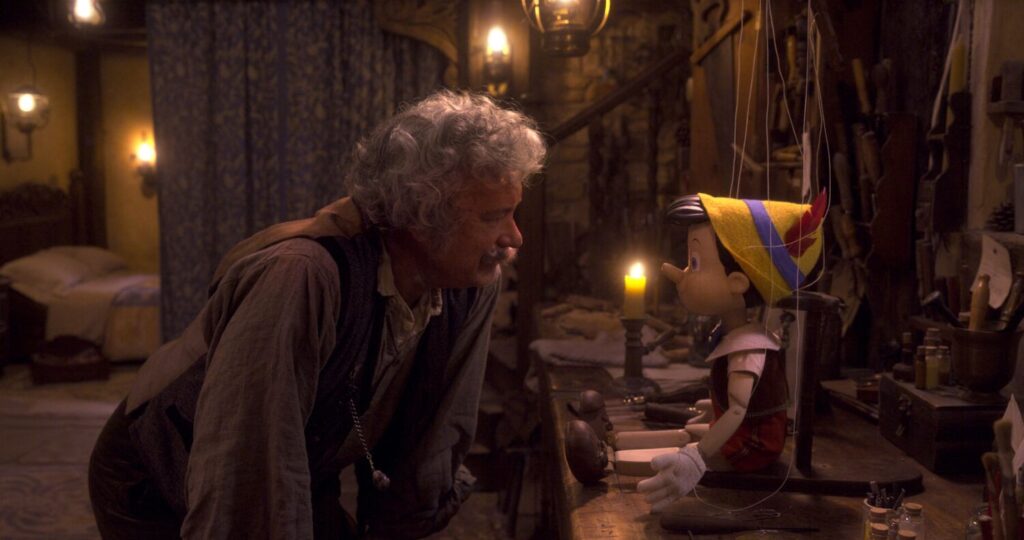It may have started when they shunned hand-drawn animation from their feature productions, or perhaps when churning out superhero sequels became their mainstay. But regardless of where it began, the cheapening of the wonder Disney films once evoked reached its nadir with the notorious, pseudo live-action remakes of the studio’s cartoon classics.
Produced by Walt Disney himself, the 1940 interpretation of “Pinocchio” is often regarded as one of the most accomplished and innovative animated features ever conceived. But with Robert Zemeckis’ new hybrid incarnation — which combines live-action elements and 3-D CG animation — the Oscar-winning director has carved a lackluster replica.
The Italian tale of the wooden boy who wished to become a flesh-and-bone child begins with minuscule Jiminy Cricket (voiced by Joseph Gordon-Levitt) finding refuge from the cold at the home/workshop of Geppetto (Tom Hanks), a gifted woodcarver who has completed a wide-eyed and vibrant puppet crafted in the image of his deceased son.
Named after his pinewood composition, Pinocchio (voiced by Benjamin Evan Ainsworth) becomes sentient when the Blue Fairy (the vocally gifted Cynthia Erivo) responds to Geppetto’s heartfelt calling. Authentic boyhood is within reach, she explains, if he proves himself valiant and honest. She deputizes Jiminy as the newly born figure’s voice of reason.
Early on, during this elongated opening, a clever, if pandering, sequence with cameos from a variety of other Disney characters claims the crown as the film’s most notable occurrence.
As opposed to Matteo Garrone’s recent gorgeous take or Guillermo del Toro’s upcoming stop-motion reimagining, which take aesthetic liberties, Zemeckis isn’t adapting Carlo Collodi’s 19th century fable but the previously Disneyfied version of it. This unadventurous pursuit entails imitating its characters’ details, costumes and color palette to mimic, as closely as possible, what the audience is already familiar with.
But for a movie about being real, one would be hard-pressed to pinpoint any physical elements on screen. The entirety of Zemeckis’ “Pinocchio” appears to have been shot against a green screen. The subpar digital visuals include overblown lighting in the day scenes and poorly rendered integration between the characters and the environments, especially noticeable near the end of the film during set pieces that take place in water.
None of the zombified “live action” redos of Disney animated movies has improved on the originals, but it seems that when intended solely for its streaming service, as is the case here, the quality alarmingly diminishes.
Pinocchio’s transmutation from the 2-D animated design into one with volume makes for an almost identical copy because he remains an inanimate object that can keep his cartoonish features. That differs from the unconvincing digital form that organic creatures like Jiminy, Honest John, a bipedal fox; or Geppetto’s cat Figaro assume through 21st century technology.
Outside of the film’s unflatteringly artificial look, the writing (credited to Zemeckis, Chris Weitz and Simon Farnaby) overflows with anachronistic jokes and some adult references that mostly serve as cringey attempts at modernizing the story. In an incredible feat of time mismanagement, this “Pinocchio” is about 20 minutes longer than the 1940 version and still manages to blatantly sidestep having a poignant and magical ending.
More stilted, or wooden if you will, than Pinocchio himself, the handful of human performances, including Hanks, overflow with an unnatural theatricality that creates a tonal dissonance with the subtler acting of their digital counterparts.
Even the promising addition of Fabiana (Kyanne Lamaya), a compassionate puppeteer, and her ballerina marionette Sofia to Pinocchio’s journey eventually turns inconsequential.
There’s a clear through line connecting Zemeckis’ longstanding affinity for animation and the utilization of technological advancements in storytelling. That boldness has resulted in glorious totems of American cinema such as “Who Framed Roger Rabbit” and “Back to the Future,” but also misfires of cinematic experimentation such as “Beowulf,” “The Polar Express” or the abysmal “Welcome to Marwen.” Unfortunately, this effort joins the latter group.
Zemeckis’ “Pinocchio” prompts one to wish upon a star that Disney would stop diluting the legacy of its beloved animated features with these soulless knockoffs. But with several more already in the pipeline, it seems unlikely that the corporation will listen anytime soon to the Blue Fairy’s warning about avoiding falsehoods and following your conscience.
‘Pinocchio’
Rated: PG, for peril/scary moments, rude material and some language
Running time: 1 hour, 51 minutes
Playing: Available Sept. 8 on Disney+

